Aromatic Highly aromatic substances, originally describing rich, balsamic essences but now commonly applied to any pleasantly scented botanical materials. |
|
Artabotrys Odoratissimus Country of origin the Philippines and Indonesia. See: Ylang Ylang |
|
Artemisia Alba 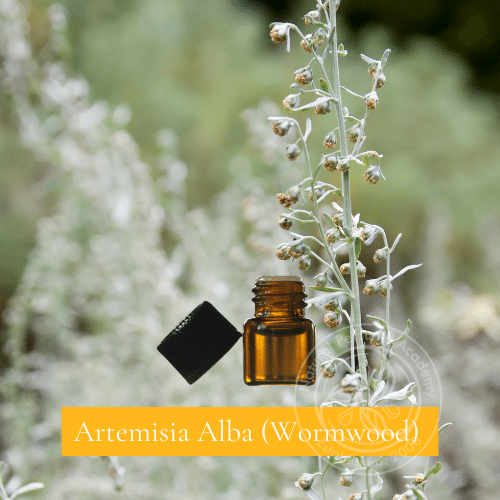
Title: Artemisia Alba (Wormwood) Description:
Artemisia Alba, a perennial plant native to Mediterranean countries, is closely related to the wormwood plant and shares similar silvery leaves. Its essential oil is known for its distinctive aromatic properties. Characteristics:
The oil of Artemisia Alba is characterized by its very green and bitter notes. This potent, herbaceous scent makes it a unique addition to the perfumer's palette, offering a fresh and sharp aroma that can add complexity to various fragrance compositions. Country of Origin:
Artemisia Alba is primarily found in Mediterranean regions, where it thrives in the local climate and soil conditions. Perfume Type and Combinations:
Artemisia Alba oil is particularly useful in chypre and green perfumes. Its green, bitter notes provide an excellent counterbalance to sweet and floral elements, creating a sophisticated and layered fragrance. It pairs well with other green and herbal notes, as well as woody and citrus elements, enhancing the overall complexity and depth of a perfume. Usage in Natural Perfumery:
In natural perfumery, Artemisia Alba oil is valued for its ability to introduce fresh, green, and bitter nuances to a composition. It is especially effective in creating bold, dynamic scents that stand out for their uniqueness and complexity. Reference:
Steffen Arctander; Perfume and Flavor Materials of Natural Origin. |
|
Artemisia Annua 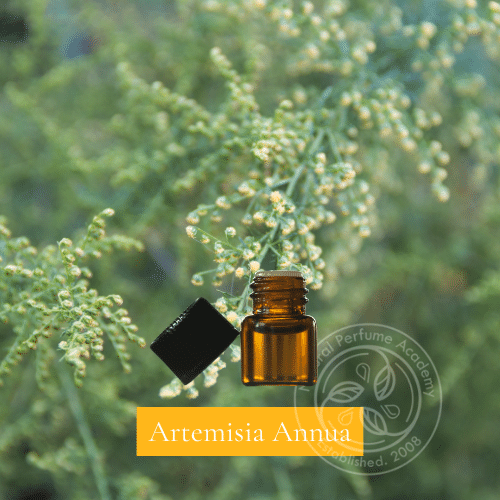
Title: Artemisia AnnuaArtemisia Annua, also known as sweet wormwood, is a plant native to Yugoslavia. It is distinguished from other Artemisia species by its high yield, which makes it the least expensive of the Artemisias. Characteristics:
The essential oil of Artemisia Annua has a green, basil-like odor. This fresh, herbaceous scent is appealing and versatile, though it is predominantly used in more utilitarian applications. Country of Origin:
Artemisia Annua is primarily cultivated in Yugoslavia, where the conditions are favorable for its growth and high yield. Perfume Type and Combinations:
Due to its green, basil-like fragrance, Artemisia Annua oil is commonly used as a perfuming material for soaps. Its fresh and herbaceous notes blend well with other green and herbal scents, as well as floral and citrus elements, making it suitable for creating clean and refreshing aromatic profiles. Usage in Natural Perfumery:
In the realm of natural perfumery, Artemisia Annua is valued for its affordability and its ability to impart a clean, green note to products. It is less commonly used in fine perfumery due to its more utilitarian scent profile but is an excellent choice for everyday products like soaps and household items. Reference:
Steffen Arctander; Perfume and Flavor Materials of Natural Origin. |
|
Attar 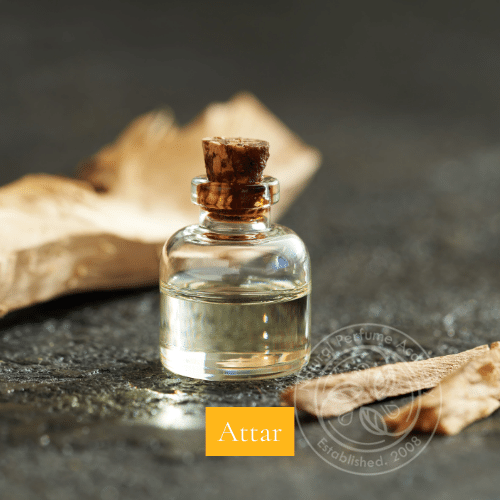
Title: AttarDescription:
Attar, also known as Ittar, is a traditional form of perfume originating from South Asia and the Middle East. It is typically created through the hydro-distillation process, where sandalwood oil serves as the base medium for the extraction of fragrant compounds from flowers. Characteristics: - Base Oil: The primary base oil used in the production of attar is sandalwood oil, prized for its deep, woody, and long-lasting scent.
- Fragrance Profile: The final fragrance of an attar varies significantly depending on the flowers or plant materials used in the distillation process. Common floral ingredients include roses, jasmine, and other aromatic flowers, which impart a rich, complex, and enduring scent to the sandalwood base.
- Appearance: Attars are usually oil-based and can range in color from clear to pale yellow or green, depending on the source materials.
Country of Origin:
Attars have a long history in South Asia and the Middle East, particularly in countries like India, where traditional methods of attar production are still practiced. Perfume Type and Combinations:
Attars are highly concentrated and used sparingly in natural perfumery. They are often worn as single-note fragrances or blended with other essential oils to create bespoke scents. The combination of the floral top notes with the deep, grounding sandalwood base makes attars versatile for both personal wear and in the creation of complex perfume compositions. Usage in Natural Perfumery:
In natural perfumery, attars are cherished for their purity, depth, and longevity. They are used in high-end perfume formulations, as well as in aromatherapy and spiritual practices due to their natural origins and therapeutic properties. Traditional Significance:
Attars hold cultural and historical significance in various traditions, often used in religious ceremonies, as offerings, and in daily grooming rituals. They are considered luxurious and are sometimes presented as gifts during special occasions. Reference: - Steffen Arctander; Perfume and Flavor Materials of Natural Origin.
- Traditional perfumery practices in South Asia and the Middle East.
|
|
Balsam 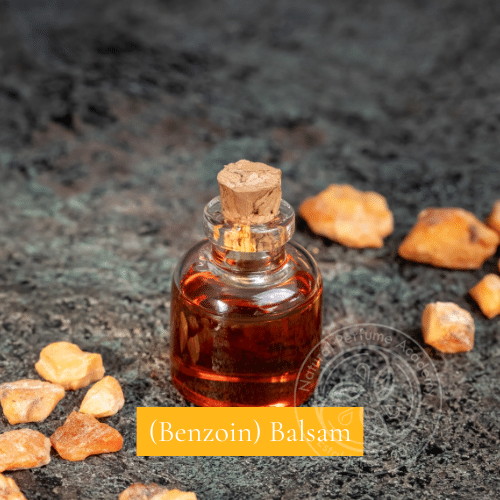
Title: BalsamDescription:
Balsam refers to a natural resinous substance exuded by certain trees and plants. This material can be a physiological product of the plant’s normal growth processes or a pathological product resulting from injury or disease. Balsams are known for their aromatic properties and have been used in perfumery and medicine for centuries. Characteristics: - Appearance: Balsams typically have a viscous, sticky texture and can range in color from golden yellow to dark brown.
- Fragrance Profile: They are renowned for their rich, warm, and sweet aromatic properties, often with notes of vanilla, cinnamon, or honey. The scent can be both soothing and uplifting.
- Composition: Balsams contain a mixture of essential oils, resin acids, and other volatile compounds that contribute to their complex aroma.
Examples of Balsams: - Peru Balsam: Extracted from the Myroxylon balsamum tree, it has a sweet, vanilla-like scent.
- Tolu Balsam: Derived from the Myroxylon balsamum var. pereirae tree, known for its warm, spicy, and cinnamon-like fragrance.
- Benzoin: Obtained from the Styrax benzoin tree, it has a sweet, vanilla, and almond-like aroma.
Country of Origin:
Balsams are typically sourced from tropical and subtropical regions, including Central and South America, Southeast Asia, and parts of Africa. Perfume Type and Combinations: - Usage in Perfumery: Balsams are prized for their fixative properties, helping to stabilize and prolong the life of a perfume’s aroma. They are commonly used in oriental, woody, and amber fragrance compositions.
- Blending: Balsams blend well with other resins, spices, and floral notes. They are often combined with ingredients like vanilla, frankincense, sandalwood, and rose to create rich, complex perfumes.
Applications in Natural Perfumery:
Balsams are valued in natural perfumery for their depth and longevity. They add warmth and sweetness to blends and are used in both top-end luxury perfumes and therapeutic aromatherapy products. Traditional and Medicinal Uses:
Historically, balsams have been used in traditional medicine for their healing properties. They are known for their antiseptic, anti-inflammatory, and soothing effects, making them useful in treating wounds, respiratory issues, and skin conditions. Reference: - Steffen Arctander; Perfume and Flavor Materials of Natural Origin.
|
|
Balsamic 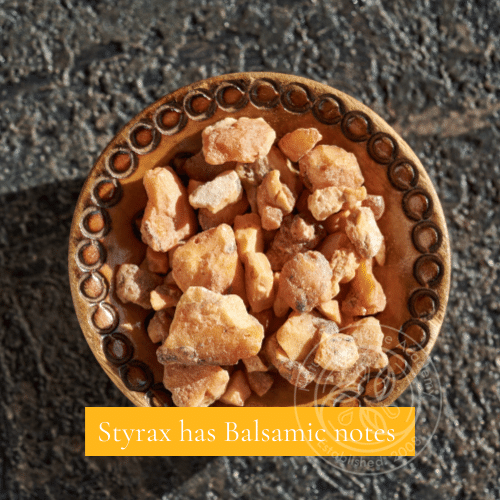
Title: BalsamicDescription:
Balsamic refers to a specific quality of fragrance notes characterized by their sweet, warm, and rich scent profile. These notes are often derived from natural resins and balsams, which exude a comforting and enveloping aroma. Characteristics: - Scent Profile: Sweet, warm, woody, and rich.
- Complexity: Often deep and multifaceted, providing a long-lasting and soothing base for perfumes.
- Aromatic Qualities: Balsamic notes can evoke a sense of warmth and sweetness, often with hints of vanilla, spice, or honey.
Examples of Balsamic Notes: - Tolu Balsam: Known for its warm, spicy, and cinnamon-like aroma.
- Benzoin: Renowned for its sweet, vanilla, and almond-like scent.
- Peru Balsam: Offers a sweet, vanilla-like fragrance.
- Styrax: Provides a sweet, resinous, and slightly leathery note.
Perfume Type and Combinations: - Usage in Perfumery: Balsamic notes are frequently used as base notes in perfumery due to their longevity and ability to anchor a fragrance. They add depth and richness to oriental, woody, and amber compositions.
- Blending: These notes blend exceptionally well with spices, woods, florals, and other resins. Common pairings include ingredients like sandalwood, frankincense, vanilla, and patchouli.
Applications in Natural Perfumery:
Balsamic notes are highly valued in natural perfumery for their ability to provide a rich and enduring foundation to perfumes. They contribute to the overall complexity and depth of a fragrance, making them essential in both luxury and therapeutic blends. Traditional and Cultural Significance:
Balsamic materials have been used throughout history not only in perfumery but also in traditional medicine and rituals. Their soothing and healing properties have made them popular in various cultural practices around the world. Reference: - Steffen Arctander; Perfume and Flavor Materials of Natural Origin.
|
|
Base Notes 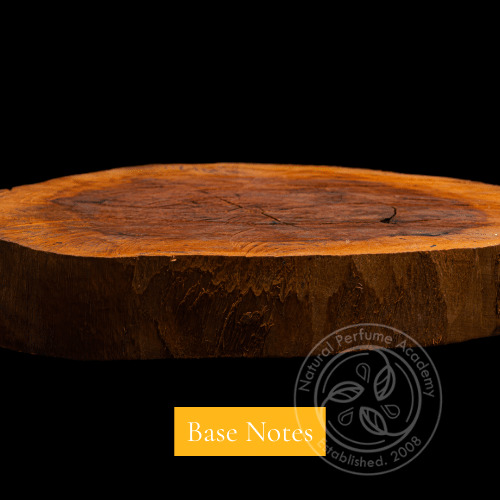
Title: Base NotesDescription:
Base notes form the sturdy foundation of a natural perfume composition, offering depth, richness, and longevity to the fragrance. Derived solely from natural botanical sources, these notes are renowned for their earthy, grounding, and enduring qualities. Characteristics: - Scent Profile: Deep, warm, and persistent, evoking the essence of the earth and forests.
- Longevity: Base notes boast exceptional staying power, lingering on the skin for extended periods.
- Evaporation Rate: Slow, ensuring a gradual release of aroma over time.
Examples of Base Notes (100% Natural): - Woody: Sandalwood, Cedarwood, Vetiver, Patchouli
- Balsamic: Benzoin, Tolu Balsam, Peru Balsam
- Resinous: Frankincense, Myrrh, Labdanum
- Earthy: Oakmoss, Vetiver, Patchouli
- Musk: Ambrette Seed, Angelica Root, Labdanum
- Vanillic: Vanilla Absolute, Tonka Bean
Perfume Type and Combinations: - Usage in Natural Perfumery: Base notes are indispensable in natural perfumery, providing a solid foundation and enhancing the overall complexity of the fragrance. They harmonize beautifully with floral, herbal, and resinous notes, creating well-rounded and captivating scent profiles.
Applications in Natural Perfumery:
In natural perfumery, base notes are prized for their authenticity and purity. Sourced from botanical treasures, these ingredients imbue fragrances with a deep connection to nature. They are meticulously crafted to ensure sustainability and ethical sourcing practices. Role in the Fragrance Pyramid: - Top Notes: Initial, fleeting impressions, often bright and citrusy.
- Middle Notes (Heart Notes): The essence of the fragrance, floral or herbal, unfolding after the top notes dissipate.
- Base Notes: The enduring foundation, grounding the fragrance with their earthy and woody allure, persisting long after the other notes fade.
Cultural and Historical Significance:
Base notes have been revered throughout history for their profound connection to the natural world. Used in ancient rituals, ceremonies, and healing practices, these botanical treasures have stood the test of time, symbolizing resilience, strength, and harmony. Reference: - Steffen Arctander; Perfume and Flavor Materials of Natural Origin.
|
|
Bee goo 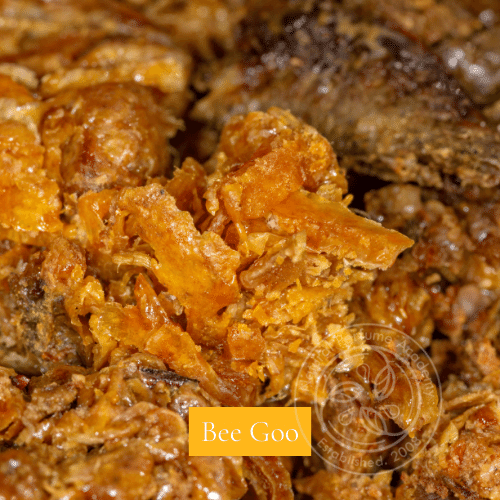
Title: Bee GooDescription:
"Bee Goo" is a colloquial term used in natural perfumery to describe a unique substance derived from the remnants of bee activity within a hive. This material comprises a blend of various hive components, including wax residues, pollen, propolis, and fragments of bees themselves. These remnants are typically collected during the extraction of beeswax from the hive and undergo a maceration process in alcohol. Characteristics: - Composition: A complex amalgamation of natural substances produced by bees within the hive environment.
- Texture: Varies depending on the composition, ranging from viscous and sticky to granular or powdery.
- Aroma: The scent profile of Bee Goo is multifaceted, incorporating elements of beeswax, floral undertones from pollen, and the resinous, balsamic notes of propolis.
- Fixative Properties: Bee Goo exhibits notable fixative qualities, enhancing the longevity and tenacity of fragrances to which it is added.
Preparation and Ageing:
After collection, the raw materials undergo a maceration process in alcohol, allowing for the extraction of aromatic compounds and fixative properties. The duration of maceration is crucial, with Bee Goo typically aged for a minimum of eight months to achieve optimal fixative qualities and aromatic complexity. Usage in Perfumery: - Fixative Agent: Bee Goo is valued in perfumery for its ability to anchor fragrances, extending their longevity and enhancing their overall olfactory profile.
- Natural Essence: As a product of the hive, Bee Goo offers a unique olfactory experience, capturing the essence of bees and their environment in a single substance.
- Artisanal Crafting: Perfumers and artisans often incorporate Bee Goo into natural perfume formulations, adding depth, richness, and authenticity to their creations.
Application:
Bee Goo finds application in various perfumery products, including solid perfumes, balms, and botanical blends. It serves as a natural alternative to synthetic fixatives, aligning with the principles of sustainable and eco-conscious fragrance formulation. Cultural and Historical Significance:
Throughout history, bees and their hive products have held cultural significance, symbolizing industriousness, community, and the bounty of nature. Bee Goo encapsulates this rich heritage, offering perfumers a connection to age-old traditions and the natural world. Reference: - Research and insights from natural perfumery practitioners and artisans.
|
|






